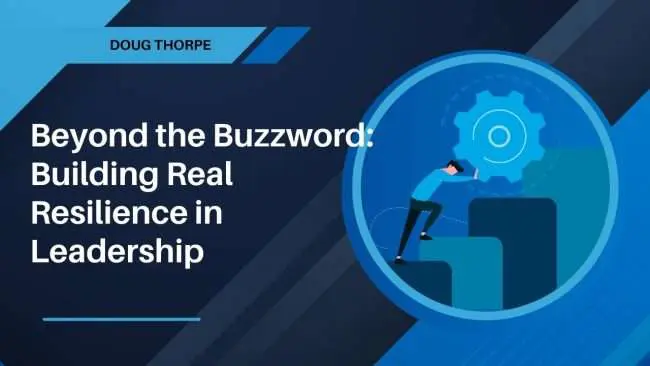Beyond the Buzzword: Building Real Resilience in Leadership
Resilience. It’s a term tossed around like a corporate beanbag these days, a leadership quality on every hiring manager’s wishlist. But what does it truly mean?
The Resilience Matrix: It’s Not Just Bouncing Back
The resilience matrix we introduce here is a powerful tool for understanding the leadership qualities needed to thrive in today’s dynamic business landscape. Let’s delve deeper into each axis to gain a more nuanced perspective:
The Vertical Axis: The Business Rollercoaster
Imagine a heart rate monitor graph, but instead of heart rate, it tracks the ebbs and flows of your business journey. This axis represents the inevitable ups and downs you’ll encounter:
- Market Fluctuations: Economic trends, competitor actions, and unforeseen events can cause sudden shifts in your market landscape. A resilient leader anticipates these fluctuations, adapts strategies, and identifies new opportunities amidst the change.
- Unexpected Challenges: Murphy’s Law applies in business. Disruptions like supply chain issues, technological breakdowns, or even natural disasters can throw a wrench into your plans. Resilience means having contingency plans in place and the ability to think on your feet to navigate these challenges effectively.
- Wins and Victories: The good times are crucial too! Periods of Growth, successful product launches, or exceeding financial targets are essential for motivation and team morale. A resilient leader celebrates these wins while keeping a focus on continuous improvement and long-term goals.
The Horizontal Axis: The Marathon Mindset
This axis represents the long-term perspective needed for sustainable success. Building a thriving business is a marathon, not a sprint. Here’s what this translates to:
- Pacing Yourself and Your Team: Burning the candle at both ends isn’t a recipe for resilience. A resilient leader understands the importance of pacing and prioritizes a sustainable work ethic. This involves setting realistic goals, delegating tasks effectively, and encouraging breaks and work-life balance for yourself and your team.
- Adaptability and Continuous Learning: The business landscape is constantly evolving. A resilient leader embraces lifelong learning, stays updated on industry trends, and adapts strategies as needed to ensure their business remains competitive and relevant.
- Building a Sustainable Foundation: Resilience isn’t just about weathering storms; it’s about building a business that can withstand them. This involves establishing strong financial reserves, fostering a culture of Innovation, and cultivating strong Relationships with key partners.
The Intersection: Where True Resilience Lies
The sweet spot of this matrix is where real leadership magic happens. Here’s how resilience empowers you to navigate it:
Riding the Waves (Ups & Downs):
- Develop Problem-Solving Skills: Sharpen your critical thinking and analytical abilities. Conduct regular SWOT analyses (Strengths, Weaknesses, Opportunities, Threats) to identify and address potential issues before they escalate.
- Embrace Calculated Risks: Don’t be afraid to take calculated risks. Resilience isn’t about stagnation; it’s about calculated leaps of faith informed by data and a clear understanding of potential pitfalls.
- Learn from Setbacks: Turn setbacks into stepping stones. Conduct post-mortems on failures to identify what went wrong and how to improve for the next challenge.
Pacing for the Long Haul (Marathon Mindset):
- Set SMART Goals: Establish Specific, Measurable, Achievable, Relevant, and Time-bound goals. This approach creates a clear roadmap for success and keeps you motivated over the long term.
- Delegate and Empower: You don’t have to do it all. Delegate tasks effectively and empower your team members to take ownership. This fosters a sense of shared responsibility and prevents Burnout.
- Maintain a Positive Outlook: A positive attitude is contagious. Celebrate small wins, acknowledge progress, and focus on the long-term vision to keep yourself and your team motivated.
- Prioritize Work-Life Balance: Schedule breaks, disconnect after work, and encourage your team to do the same. A healthy work-life balance prevents burnout and allows you to return to challenges with renewed energy.
By applying these strategies within each quadrant of the resilience matrix, you’ll equip yourself and your team to navigate the inevitable ups and downs of the business world with confidence and determination. Remember, resilience is a journey, not a destination. Keep learning, adapting, and growing, and you’ll find yourself leading your team through any storm.
Building Your Resilience Muscle
So how do you cultivate this leadership superpower? Here are some tips:
- Embrace a Growth Mindset: View setbacks as learning experiences. Analyze them, adapt your approach, and move forward stronger.
- Prioritize Self-Care: A well-rested, healthy leader is a resilient leader. Prioritize Sleep, Exercise, and activities that replenish your mental and physical reserves.
- Foster Open Communication: Create a safe space for your team to share concerns and ideas. Open communication builds trust and fosters collaboration, crucial for navigating challenges together.
- Celebrate Milestones, Big and Small: Acknowledge progress, both during victories and periods of perseverance. Celebrating small wins keeps motivation high throughout the marathon.
By understanding the true nature of resilience and incorporating these practices, you can move beyond the buzzword and build a leadership style that thrives in the face of any challenge. Remember, resilience isn’t about avoiding the bumps; it’s about navigating them with skill, determination, and a team by your side.
The post Beyond the Buzzword: Building Real Resilience in Leadership appeared first on Business Advisor and Executive Coach | Doug Thorpe.
Small business owners will hit an invisible wall that can stall the growth of the company. The key reason there is a wall is that owners need to shift from manager to leader. The question is, how to do that?
Doug is a coach for CEOs and Senior Leadership Teams with 30 years of leadership experience. He is the president & CEO of Doug Thorpe Group. Doug is also a podcast host.
He helps owners understand the ways they need to reshape their thinking and attitude to make a successful break through the wall.
